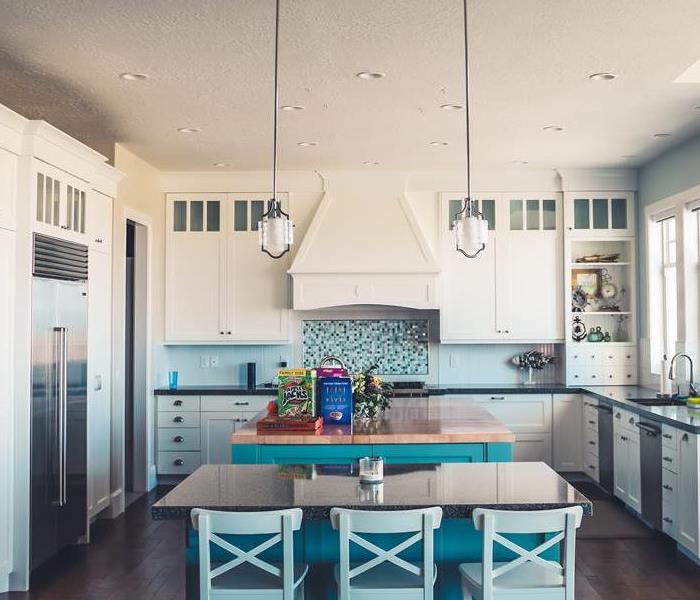Top Culprits of Water Damage in Indianapolis Homes
7/17/2018 (Permalink)
By knowing what the top causes of water damage to Indianapolis homes, you can be proactive and check these common culprits on a regular basis to reduce the chance of water damage occurring to your Indianapolis home. Below are the top causes of water damage to your home outside of a natural disaster like flooding.
Refrigerator
If you notice water pooling below your kitchen refrigerator, you most likely either have a water line that is leaking or a freezer that is not cold enough. Check the bottom of your freezer to see if there is standing water or ice forming. As the water or ice forms, it can melt and leak every time you open the freezer. If you don’t find ice or water forming at the bottom of your freezer, you may have a water line that is loose or leaking.
The water line is used to make ice and sometimes provide water in the refrigerator door. The line is usually located in the back of the refrigerator and can be knocked causing a slow leak. It’s a good idea to occasionally check around your refrigerator for standing water and fix the problem before the water gets worse or causes damage to your floors.
Dishwasher
Much like your refrigerator, a dishwasher can leak water for a while until it is discovered. The water line and/or the drain to the dishwasher is usually connected at the back of the dishwasher and any leaks could take weeks or months to appear. While you can’t do anything about hidden leaks, the other commonplace that a dishwasher leaks is around the door. If the seals around the door have been cracked or compromised, water can leak out while it is running and pool below the dishwasher.
It’s always a good idea to check on a regular basis around the bottom of your dishwasher for any standing water or signs of water. If you do find any signs, you can then further investigate to determine if it’s around the door or if it’s coming from the water or drainage line hidden behind your dishwasher.
Washing Machine
You can probably start to see a pattern here. While water can come through a damaged roof or windows or under doors, it’s common appliances and household items that are hooked up to water that tend to cause most water damage in homes.
The washing machine is no exception to leaking, with its water intake and water drainage. Water can also leak out around the door of the washing machine from old or damaged seals. Just like your dishwasher, it’s important to regularly check around your washing machine for any signs of water leakage. Check the water hookup, water drainage, and around the door for signs of water.
Toilet
The water leaking from a toilet can be particularly bad. If the water is leaking from the back tank, then the water is most likely clean and while it is still bad, it’s not as bad of a situation if the water leaking is coming from around the toilet drain. Toilets usually drain the content of their bowl down underneath the toilet where it connects with the sewer drain. To prevent leaking and odors, the toilet drain is seated with a wax ring into the sewer drain. If your toilet is not completely bolted down or becomes loose over time, the wiggling can break the wax seal causing dirty, contaminated water to seep out below the toilet. If not discovered, this water can seep into the floor and cause serious water damage and most likely mold damage.
If you notice your toilet wiggles, check for any signs of water leakage and tighten down your toilet. If you do find water, then you may have to buy a new wax ring and reseat your toilet although you might want to have a water damage professionals check for any water or mold damage before tightening back the toilet.
Air Conditioner
The last common source of water damage in homes is the air conditioner. Whether you have a central air conditioner or window ac units, they both can cause water to leak and damage your home. In both systems, the air conditioner typically creates a lot of condensation when running in the hot summer. This condensation is usually gathered in a pan where it then drains outside or into a drain. If the drain becomes clogged, the water in the pan can overflow and drip inside your home or into other parts of the air conditioner where it can promote mold growth.
If you notice your vents are blowing air that smells moldy or like a damp basement, then you need to check for standing water or mold growth around the blower, filter, and cooling coils of the unit. You might also find water dripping or pooling around the unit. Again, just like your other appliances, it’s a good idea to regularly check your air conditioner as well as maintain it.
If You Do Have Water Damage, Call the Pros
If you do discover water damage from any of the above culprits or from other places like a leaky roof or burst pipe, it’s important to call water damage restoration experts at SERVPRO of Indianapolis West as soon as possible. Water damage can quickly get much worse if not treated immediately. Water can seep and soak further into the floors and walls causing more damage and it can also promote mold growth if not removed and treated quickly. Hopefully, you don’t have any water damage and catch it in time by regularly checking the culprits above.






 24/7 Emergency Service
24/7 Emergency Service
